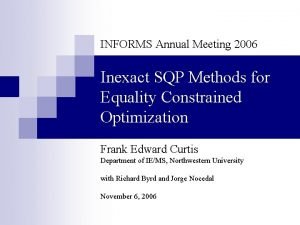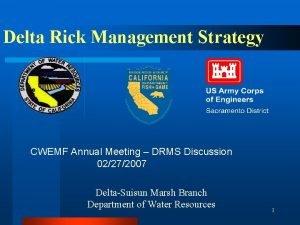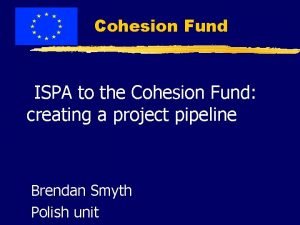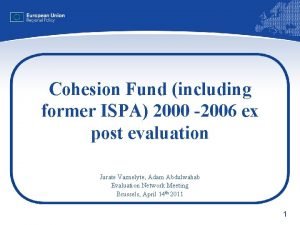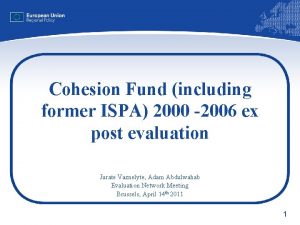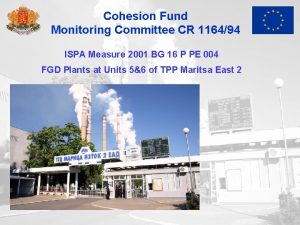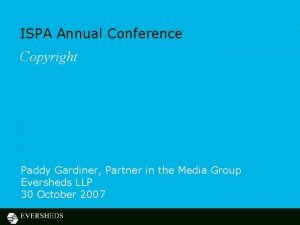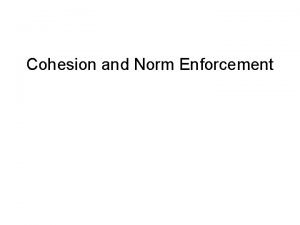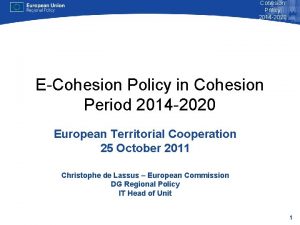Transition from ISPA to Cohesion Fund Annual Meeting

















- Slides: 17

Transition from ISPA to Cohesion Fund Annual Meeting of ISPA Partners 2003: From ISPA to Cohesion & Structural Funds Colin Walker European Commission DG Regional Policy 1

ISPA to Cohesion Fund z ISPA based closely on the Cohesion Fund èTo help candidate countries (CEECs) prepare for accession è By financing major transport and environment infrastructure needs z Introduction to procedures of Cohesion Fund (& EU Structural Actions more generally) z Transition ISPA to CF relatively straightforward 2

The Cohesion Fund: Origin and Objectives z Introduced by the Treaty on European Union èTo promote economic and social cohesion (reduce disparities in economic development) èBy helping to finance major transport and environment infrastructure needs z Linked to EMU and control of budget deficits z Cohesion Fund accounts for 35% of 2004 -06 allocations 3

ISPA to Cohesion Fund Common Features: y. Project-based approach (not programmes) y. High rates of assistance y. Focus on transport and environment y. Whole territory of member state y. Indicative allocations by country (ranges) y. Project application, appraisal & monitoring procedures 4

ISPA to Cohesion Fund Points of difference: y. Eligibility of countries y. Conditionality (convergence programmes) y. Scale (overall & by project) y. Decision procedures y. Implementation procedures y. Expenditure eligibility (timing & type) y. Other (commitments & payments) 5

ISPA to Cohesion Fund Eligibility & conditionality: Cohesion Fund èMS with GNP under 90% ISPA CEEC candidate èConvergence programme (Art. 2. 4) èConditional assistance (Art. 6) è Mid-term review 6

ISPA to Cohesion Fund Scale (overall allocations): Cohesion Fund ISPA è € 2. 8 billion p. a. 2004 -06 € 1. 14 billion p. a. è € 38 per capita p. a. € 11 per capita p. a. E. g. Poland: 2003 (ISPA) 2004 (CF) € 372 million € 1415 million 7

ISPA to Cohesion Fund Assistance rates & min. project size: Cohesion Fund è Grant rate 80 -85 % ISPA 75% (85% as exception) Y subject to revenue-generation & financing from other sources è € 10 million min. size Y € 5 million min. size except in “duly justified cases” 8

ISPA to Cohesion Fund Expenditure eligibility: Cohesion Fund è On receipt of (complete) application ISPA Date of signature of FM è Land purchase eligible è VAT in limited cases è Commission Regulation 16/2003 9

ISPA to Cohesion Fund Decision procedures: Cohesion Fund ISPA è Commission decision & financing memorandum è Information meeting Favourable opinion of management committee 10

ISPA to Cohesion Fund Implementation procedures: Cohesion Fund è Fully decentralized to MS è National law based on EC procurement directives è Ex-post control by Commission ISPA Part decentralized - External aid rules: * EU+ preference * Ex-ante approval 11

Transition from ISPA to Cohesion Fund z Accession of 10 countries by May 2004 (of which 8 are ISPA beneficiaries) z ISPA will cease for these countries, but they become eligible for CF and SFs z 2003 will be last year for ISPA in acceding countries z Ongoing ISPA projects to be completed under CF rules 12

Transition from ISPA to Cohesion Fund z Problem: Continuation of projects after accession z ISPA projects y. Commitments carried out over several years based on financial plan yin many cases commitments are distributed over the period 2004 -2006 13

Transition from ISPA to Cohesion Fund The Legal and Budgetary contraints: 1 Article 15 of the ISPA regulation : « On accession to the EU, a country shall lose its entitlement to support under this Regulation » Þ no new ISPA commitments possible after accession of a country ( i. e. 2004) 2 EU Budget financial perspectives : · pre-accession grants for candidate countries · structural actions (SF + CF) for EU Member States = a clear break between « before accession » // « after accession » 14

Transition from ISPA to Cohesion Fund The solution: As the ISPA Regulation is an adapted copy of the Cohesion Fund Regulation… … on accession of a country: All non-completed ISPA measures shall be considered as Cohesion Fund projects 1 Any subsequent annual commitment = under the Cohesion Fund 2 The provisions governing these measures = those of the Cohesion Fund [unless otherwise stated] 15

Transition from ISPA to Cohesion Fund Some specific provisions: y. Public procurement rules y. Assistance rates y. Expenditure eligibility • date • items of expenditure y. Payments 16

Transition from ISPA to Cohesion Fund Conclusions: z Close similarity between CF and ISPA èDifferences outweighed by common features z ISPA therefore provides good introduction to CF èIf ISPA a success…. . . then CF will also be a success! z Transition arrangements relatively straightforward z CF part of wider “family” of Structural Actions 17
 Kepanjangan dari ispa adalah
Kepanjangan dari ispa adalah Eu cohesion policy
Eu cohesion policy How to run an annual general meeting
How to run an annual general meeting Nrg oncology conference
Nrg oncology conference Ky masonic lodges
Ky masonic lodges Nrg oncology semi annual meeting 2018
Nrg oncology semi annual meeting 2018 Informs annual meeting
Informs annual meeting American epilepsy society annual meeting 2017
American epilepsy society annual meeting 2017 Annual theory meeting
Annual theory meeting Aashto annual meeting 2015
Aashto annual meeting 2015 Aupha annual meeting
Aupha annual meeting Cwemf annual meeting
Cwemf annual meeting Scts annual meeting
Scts annual meeting American psychiatric association annual meeting 2020
American psychiatric association annual meeting 2020 Entries are made to the petty cash account when
Entries are made to the petty cash account when Transition meeting agenda
Transition meeting agenda Meeting objective
Meeting objective What is meeting and types of meeting
What is meeting and types of meeting






